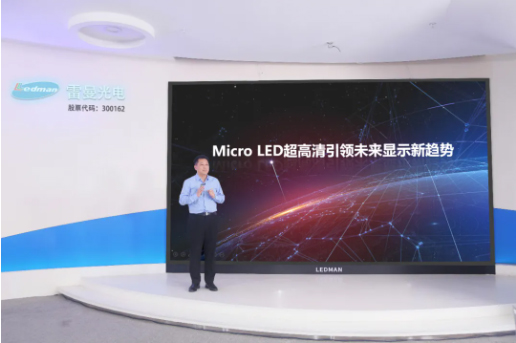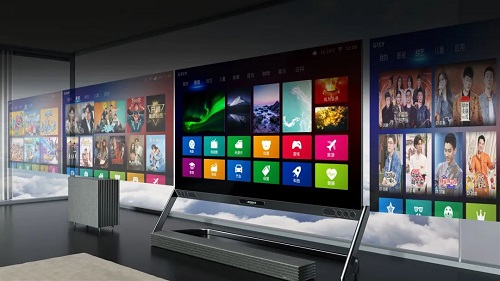The advantages of Micro
LED in contrast, gamut, resolution and color rendering have made a visual feast possible, allowing this “Black Technology” to garner consumer attention. Mostly being applied to commercial scenarios, Micro LED has been benefiting from increasingly mature technologies and reduced costs. Therefore, Micro LED is transitioning from business to consumer markets and has become the top choice of home theaters.
Micro LED Is Becoming a New Favorite of Home Theaters
According to research company TrendForce’s optoelectronics division LEDinside, the indoor LED display market—including home theater applications—is growing steadily thanks to increasing demand for high resolution and HDR displays.
LCD remains to be the major display technology for the large-size screen market, whereas Mini LED backlighting is competing with OLED in the high-end TV market. However, the three technologies have difficulty in producing 100″ and larger displays, hence their inability to create unforgettable, immersive movie-watching experiences in home theater settings.
Even if manufacturers can produce a 100″ LCD, Mini LED or OLED TV, it can be difficult to move the product into a house due to its extremely large size. For example, a citizen living in Wuhan, China bought Sony’s 100″100Z9D in March 2017. Because the TV is too big to be transported through the building gate, it was hoisted using a crane and delivered into the buyer’s apartment; the entire process costed 20,000 yuan ($3,098).
Although laser TVs are an alternative for displays of ≥100″, their color reproduction can be easily affected by ambient light, making the display effect somewhat unsatisfactory.
Compared with other technologies, Micro LED has better display and fewer limitations on product size design. Further, indoor installation of Micro LED TVs is considerably simple because of their modularized nature. Accordingly, Micro LED companies are targeting at large-size display applications such as screens for luxury homes, private cinemas, high-end clubhouses, modern offices and Esports venues.
At CES 2018, Samsung unveiled its Micro LED TV, The Wall, marking a milestone for Micro LED products entering home display markets. Later, its competitors including LG, Leyard, Skyworth and C-Seed released Micro LED products for home use, triggering the Micro LED competition in the consumer market.
The 118″ 4K model of Smart Wall launched by Konka in 2019 is priced at 1.68 million yuan ($260,344), whereas the largest 236″ 8K model costs 8.88 million yuan ($1.38 million). LG’s MAGNIT of 163″ in size, which it released in September last year, is sold at a price of $306,000.
By contrast, Ledman’s latest private home theater system is much more affordable.
From B2B to B2C, Ledman to Enter Home Electronics Market
On September 27, Ledman held a product launch event for its Micro LED
private home theater system “Large Display Luxury, Future Is Coming”. During the event—which was held offline and online simultaneously—Ledman CEO Martin Lee announced that the company’s flagship 138″ 4K Micro LED display series for home theaters was officially launched. Currently, the series is available on JD.COM (Ledman’s flagship store) and Ledman’s official website, starting at 499,999 yuan ($77,479).
The COB-based Micro LED home theater system comes with an ultra-high-definition Micro LED Display with a self-luminous nano-black coating that supports screen splicing. It features a 1-million-to-1 contrast ratio, gamut of 125%, a viewing angle of 170°, nano-grade response and HDR. With a high screen-to-body ratio and 4K resolution, the Micro LED display can present vast scenes that create strong immersion for viewers.
The theater system is incorporated with a self-developed smart system that has established a whole new interaction model. Moreover, the home theater display is compatible with 7.1.4 Dolby Atmos speakers, which can create immersive sound effects.
With 17 years of experience in IC packaging, 16 years of experience in display manufacturing and 7 years of experience in Micro LED research and development, Ledman now has 300+ patents in China (60 of which are related to COB), thereby creating a comprehensive intellectual property system.
The launch of the Micro LED home theater system signifies that Ledman has shifted from the B2B model to B2C model, officially entering the consumer market.
Conclusion
Since the birth of LED displays, their pixel pitch has continued to decrease from 2.5mm, 2mm, 1.5mm to 1.2mm.
Today, LED displays with a pixel pitch of 1.0mm (and smaller) have been developed, which are known as fine pitch Mini/Micro LED displays.
Leading display makers from all over the world originally cut their efforts in the large-size LED display market. Following the development of Mini/Micro LED in recent years, however, these giant companies have readjusted their strategies with the hope of claiming a share in the promising large-size Micro LED display market.
Chinese firms are no exception and have strived to develop large-size Micro LED products, which can be exemplified by Ledman launching a Micro LED home theater system.
However, Micro LED suppliers are faced with major technical challenges such as problems related to epi wafers, chips, mass transfer, full color display, power driving methods, backplanes, testing and repair. These challenges have made the production cost of Micro LEDs higher than that of other LED components.
As Ledman indicates, unlike the conventional SMD and IMD (4-in-1) packaging approaches, COB is a combination of midstream suppliers’ packaging and downstream suppliers’ display technologies, thereby saving the mount cost and several production procedures with relatively higher production efficiency and narrower pixel pitch. The advantage of COB products in overall cost is noticeable. In addition to the cost of raw materials provided by upstream suppliers, the cost of COB products is affected by various factors including improvements in production process and design, modularization and replacement materials. In the coming years, the COB cost is forecast to decrease by 10%–15% annually.
PlayNitride CEO Yun-Li Li revealed that the cost of Micro LED is estimated to decrease by 95% within five years, enabling the use of such technology to shift from high-end markets to mid- and low-end markets in 2025.
In sum, as technologies continue advancing with reduced costs, Micro LED displays will be more often seen in average houses and many other scenarios, bringing ultimate audiovisual experiences to consumers.




